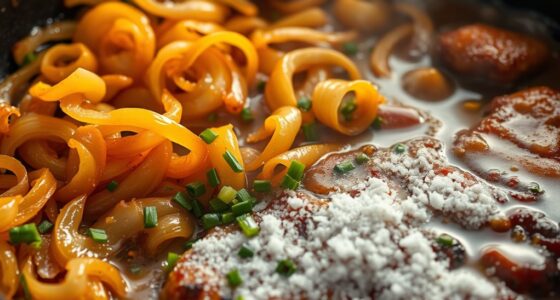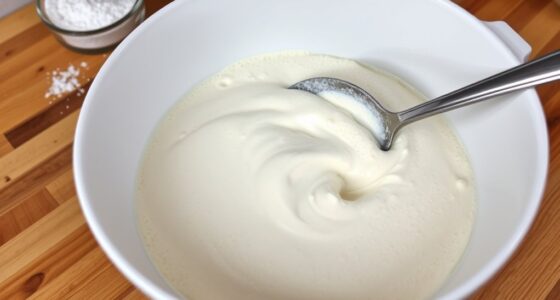Metals rust because they react with oxygen and moisture in the environment, creating a chemical process called oxidation. When iron or steel come into contact with water and air, they form iron oxides, which look like rust. Factors like humidity, salt, and temperature speed up this process. If you want to understand how rust affects structures and what you can do about it, keep exploring the details below.
Key Takeaways
- Rust forms when iron reacts with oxygen and water, creating iron oxides that weaken the metal.
- Moisture, humidity, and salt accelerate corrosion by increasing water contact and conductivity.
- Oxygen acts as an oxidizing agent, facilitating the chemical reaction that produces rust.
- Metals like steel and iron are more prone to rust due to their tendency to oxidize easily.
- Protective coatings and treatments help prevent rust by blocking water and oxygen from reaching the metal surface.
The Chemical Process Behind Rust Formation

Rust formation occurs through a chemical reaction where iron interacts with oxygen in the presence of water or moisture. In this process, iron atoms lose electrons to oxygen atoms, creating iron ions and forming oxides. The oxygen acts as the oxidizing agent, while iron serves as the reducing agent, enabling electron transfer. This electron transfer is a key step in the oxidation process. The overall reaction can be summarized as iron + oxygen + water → iron oxide (rust). Rust mainly contains iron(II) oxide (FeO) and iron(III) oxide (Fe₂O₃), with the latter giving rust its reddish-brown color due to hydration. Water is essential because it facilitates electron and ion transfer, accelerating rusting. Even humidity or water vapor can initiate this process, as moisture maintains the electrochemical reactions that weaken and degrade the metal over time. Additionally, corrosion resistance can be improved through protective coatings or alloying, which help prevent exposure to moisture and oxygen.
Metals Most Susceptible to Corrosion
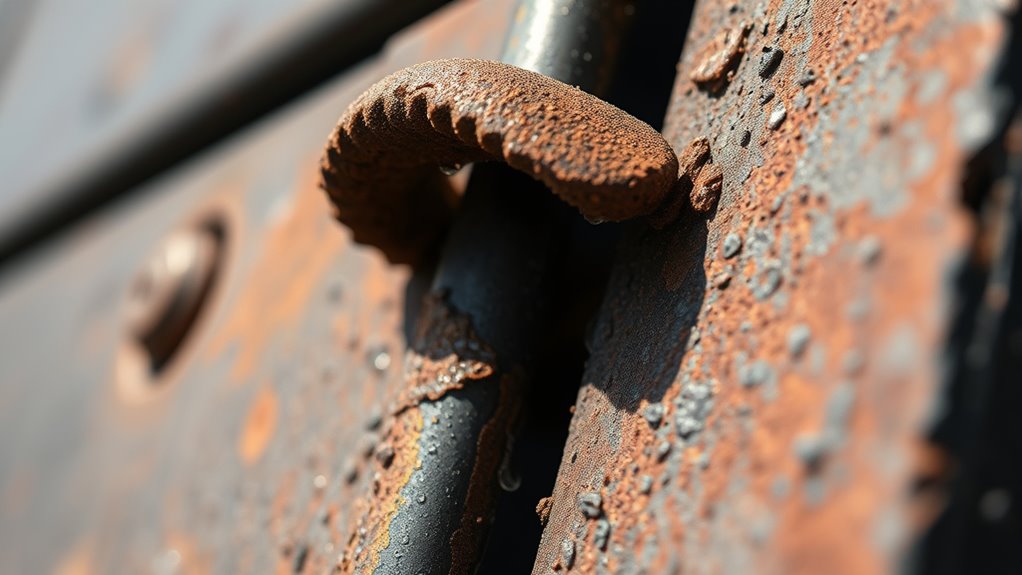
Certain metals are more vulnerable to corrosion due to their chemical makeup and environmental exposure. Carbon steel and standard iron are highly prone to rusting because they easily oxidize when exposed to moisture and oxygen. Manufacturing defects or impurities can reduce corrosion resistance even in resistant metals. Magnesium alloys have the worst corrosion resistance among metals, making them quickly degrade in humid or salty environments. Zinc, often used as a protective coating, can still corrode when exposed to acids or harsh conditions, despite its sacrificial role. Low-grade stainless steels and nickel alloys lacking sufficient corrosion-resistant elements are also susceptible, especially in aggressive environments. Corrosion resistance depends significantly on the alloy composition and environmental factors. Plain steel without protective coatings is especially vulnerable to moisture and oxygen, leading to rapid rust formation. Your choice of metal considerably impacts how quickly corrosion occurs, depending on its composition and exposure.
Environmental Factors That Accelerate Rusting
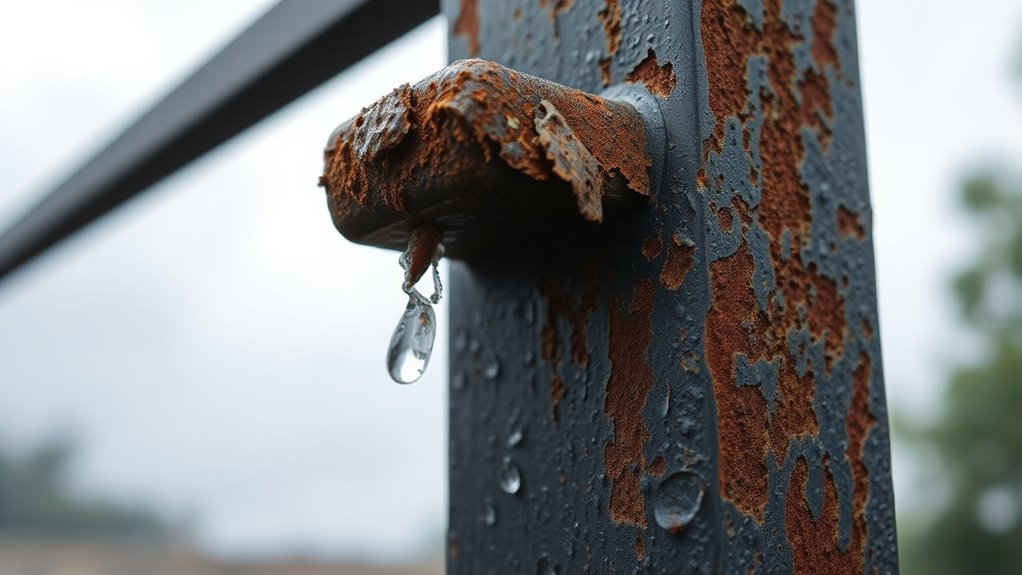
Environmental conditions play a significant role in speeding up the rusting process. Moisture is a key factor because water helps metal react with oxygen. Areas with high rainfall, dew, or condensation keep surfaces wet, increasing rust formation. Humid environments maintain moisture levels, making metals more vulnerable. Additionally, the presence of airborne pollutants can catalyze corrosion, further accelerating deterioration. Coastal regions face additional challenges due to salt in the air, which enhances corrosion even without direct seawater contact. Salt from seawater or road de-icing salts accelerates rust by increasing water conductivity and electron flow during corrosion. Temperature fluctuations also matter; warmer temperatures speed chemical reactions, while condensation from temperature changes causes moisture buildup. Industrial pollutants and particulate matter, like dust or chemicals, can further promote rust by providing reactive sites and breaking protective coatings. All these factors combine to hasten the rusting process.
How Rust Affects Structures and Economy
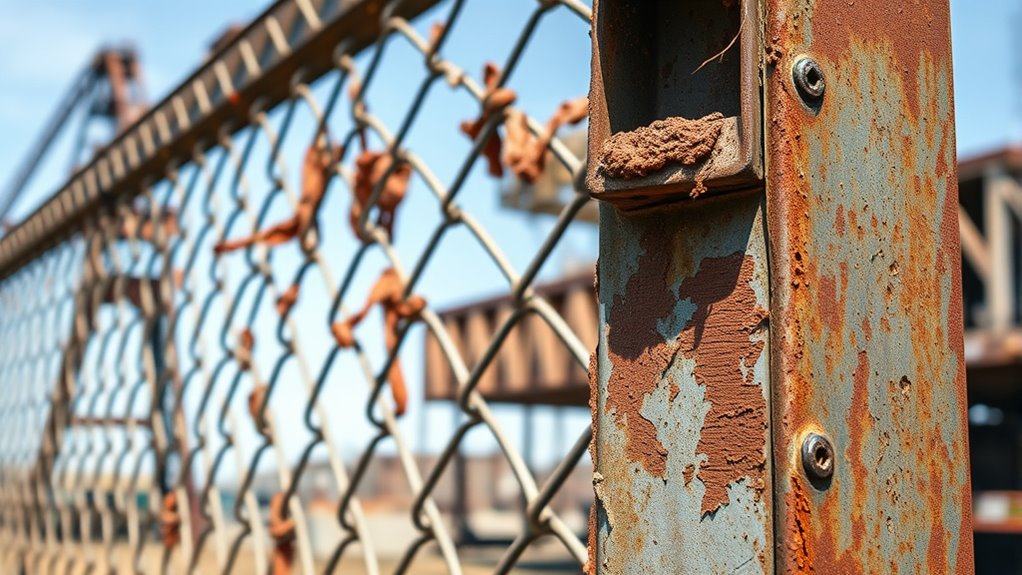
When metal structures corrode, their strength and stability weaken, posing serious safety risks. Rust causes cracks, holes, and pitting, which compromise durability and can lead to structural failure. This deterioration often results in costly repairs and increased maintenance expenses. Additionally, understanding the security measures involved in payment processing can help protect infrastructure-related data from cyber threats. Rust-related damage can lead to structural collapses, endangering lives and incurring legal liabilities. Public infrastructure like bridges, roads, and buildings become unsafe, requiring frequent repairs. While rust creates jobs for maintenance workers, it also shortens the lifespan of structures and equipment, ultimately raising costs and impacting productivity and community safety.
Techniques to Prevent and Protect Metals

Protecting metals from corrosion involves a variety of effective techniques that create barriers or alter electrochemical reactions. Protective coatings, like paint or powder coating, act as physical barriers, preventing water and oxygen from reaching the metal surface.
Rubber-based paints and embedded metallic particles offer enhanced protection by insulating and providing cathodic protection, respectively. Galvanization involves coating steel with zinc, forming a protective alloy that sacrifices itself to shield the metal.
Using alloyed steels, especially stainless types with nickel and chromium, enhances resistance in harsh environments. Cathodic protection employs electrical methods, such as sacrificial anodes, to prevent corrosion.
Additionally, proper design, sealing joints, and regular maintenance help minimize exposure to corrosive elements and extend metal lifespan. Incorporating unique and wicked planters made from recycled materials can also serve as eco-friendly protective measures against environmental damage. Combining these techniques offers robust defense against rust and deterioration.
Real-World Examples of Metal Corrosion
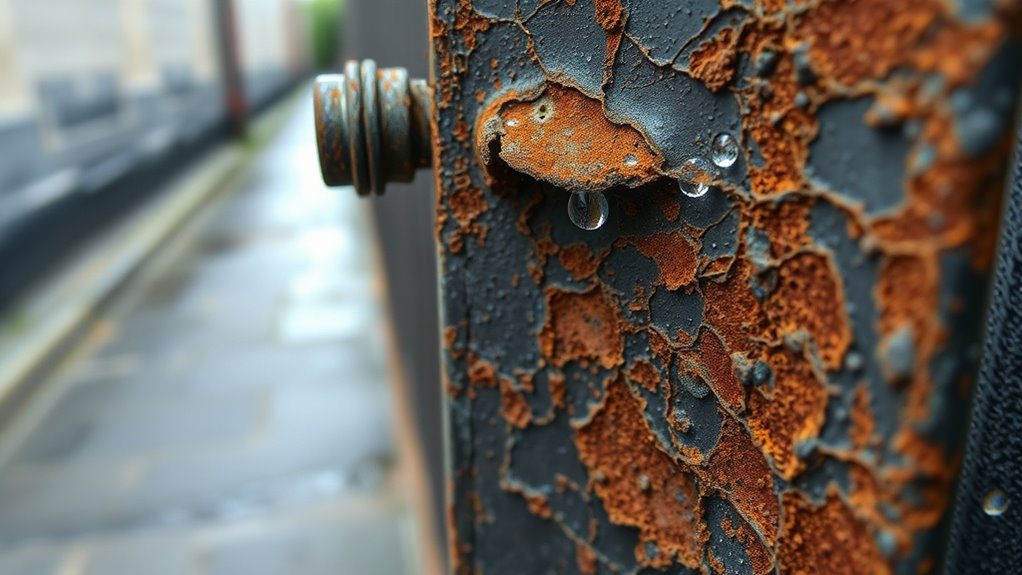
Metal corrosion is a real-world issue that affects many structures and objects around us, often with serious consequences. For example, the collapse of the Genoa Bridge in 2018, which caused 43 deaths, was linked to corrosion weakening the structure.
Pipelines often suffer from internal and external corrosion, risking leaks and contamination. Marine environments expose ships and offshore platforms to saltwater, accelerating deterioration. The Statue of Liberty’s green patina results from oxidation over time.
Industrial equipment can corrode, leading to failures and safety hazards. You see corrosion in everyday life, like rust on iron tools, tarnish on silver, or car bodies rusting in salted roads. These examples highlight how corrosion impacts safety, durability, and maintenance across various applications.
Frequently Asked Questions
Can Rust Be Reversed Once It Has Formed on Metal Surfaces?
Rust can be reversed on metal surfaces, but it depends on the extent of the damage. If the rust is superficial, you can remove it with mechanical or chemical methods and then apply protective coatings.
However, if rust has penetrated deeply, reversing the damage becomes difficult and may require material removal or replacement. Regular maintenance and early detection are key to preventing irreversible corrosion.
Do Different Environmental Conditions Cause Rust to Form at Different Speeds?
You might notice rust forms at different speeds depending on environmental conditions. In humid, salty, or warm areas, rust develops quickly because moisture, salt, and oxygen interact more readily.
Conversely, dry or cold environments slow the process, but moisture from condensation can still cause rust over time. Temperature fluctuations and wind-blown particles also influence rust formation speed, making some locations more prone to rapid corrosion than others.
Are There Metals That Rust Faster Than Iron in Similar Environments?
You might find that some metals rust faster than iron in similar environments. Magnesium, for example, is highly reactive and corrodes quicker, especially when moisture is present.
Zinc also rusts faster and is often used to protect iron through galvanization.
Steel wool made from low carbon steel quickly rusts due to its high surface area.
These metals’ reactivity levels cause them to deteriorate faster than iron under comparable conditions.
How Does Protective Coating Application Affect Rust Formation Over Time?
Oh, you thought applying a protective coating was a magic fix? Think again! When you don’t apply it properly, or if it gets scratched, rust happily takes over.
A smooth, even coat keeps moisture and oxygen out, preventing rust over time. But neglect maintenance, and rust will party underneath, spreading faster than you can say “corrosion.” Proper application and regular touch-ups are your best defenses against the rust invasion.
Can Regular Cleaning Completely Prevent Rust From Developing?
Regular cleaning alone can’t completely prevent rust from developing. While it removes dirt, water, and salt that promote rust, moisture and oxygen exposure still exist afterward.
Without additional protective measures like coatings or paint, rust can quickly form again. To better protect your metal, combine cleaning with drying and applying protective layers, and perform regular inspections.
This approach markedly reduces rust but doesn’t entirely eliminate the risk.
Conclusion
Understanding why metals rust helps you appreciate their delicate dance with nature’s relentless touch. Rust is like a silent thief, slowly eroding strength and beauty, turning shiny metal into a ghost of its former self. But with knowledge and care, you can shield your treasures from this corrosive villain. Think of prevention as a fortress, guarding your metal’s integrity, ensuring it stands resilient against time’s corrosive tide. Safeguard your metals, and they’ll serve you faithfully for years to come.



